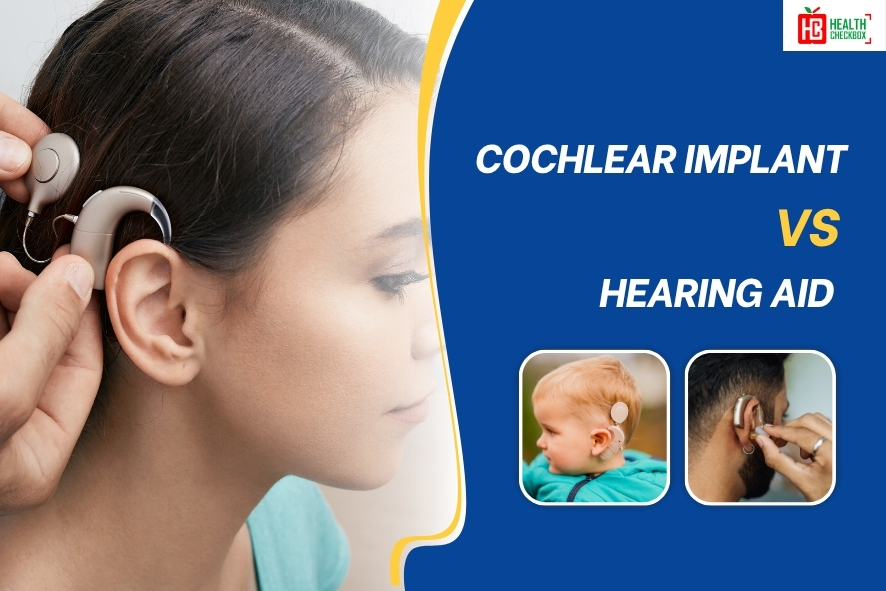Hearing loss, a common condition found in this modern age, affects several people around the globe. An effective barrier to communication can arise, especially in professions that demand regular exchange of ideas or when speakers target a large audience. Cochlear Implant Surgery vs Hearing Aid; looking at their effectiveness, differences, and benefits will help you to make an informed decision. This blog explains which one is best in cochlear implant vs hearing aid, how these two devices differ from one another, including their features, and advantages.
Both cochlear implants and hearing aids aim to help individuals restore their hearing, but certain features make them differ in their working, the degree of hearing loss they address, and their effectiveness.
What is a Cochlear Implant?
It is an electronic gadget that manages critical hearing loss in one or both ears. Your ENT doctor may suggest this device when conventional hearing aids have failed to improve the hearing effect.
Unlike hearing aids, which just amplify sound, cochlear implants stimulate the auditory nerve directly rather than the damaged hair cells in the inner ear (cochlea). This stimulation enhances the brain’s ability to identify sound. A cochlear implant is made up of 2 segments:
- The outside part includes a microphone, processor, and transmitter.
- The inside part is embedded to the rear of the ear and includes electrodes and a receiver.
Cochlear implants are often indicated for people who have substantial hearing loss and have not responded well to hearing aids. They are especially good for people who have damaged hair cells in their cochlea, which make hearing aids ineffective.
What is a Hearing Aid?
It is a tiny electronic device that enlarges sound to make it more accessible to individuals who have hearing loss. These normally treat hearing loss that is mild to moderate and increase the amplitude of sound waves to make it easier to hear. A microphone, amplifier, and speaker are the different parts of a hearing aid that operate by gathering sound from the surroundings, amplifying it, and sending it to the ear. Hearing aids are useful for many persons with mild to moderate hearing loss, but they are less successful for those with severe or profound hearing loss.
Differences Between Cochlear Implants vs Hearing Aids
A big separating point between cochlear implants and hearing aids is that the former are permanently attached while the latter is detachable. People who opt for a cochlear implant will need to undergo a medical procedure. However, inpatient surgery is required for children and people with underlying medical conditions.
| Feature | Hearing Aid | Cochlear implant |
| Objective | Amplifies sound | Bypasses impaired inner ear to stimulate nerve |
| Hearing loss level | Mild to moderate | Severe to intense |
| Placement of the device | In or behind the ear | External processor as well as internal implant |
| Sound quality | Speech clarity may not be good in noisy surroundings | Clarity is better in all surroundings |
| Cost | INR 30,000 to 3,00,000 for a pair | INR 6,00,0000 to 12,00,000 inclusive of surgery |
| Suitable for | Children and adults | Children and adults |
1. Working Use
Hearing aids: These devices work by increasing the amplitude of the sound to make it loud and clear to the listener. Sound, speech, music, and other noise is captured, digitally processed, and magnified before it is sent to the ear. However, this procedure is only effective if the hair cells in the cochlea are still functional to some extent.
Cochlear implants: These bypass deformed regions in the inner ear.
- The external sound processor captures the sound waves coming into the outer ear, analyzes, converts it to digital means, and finally sends it.
- The transmitter converts signals into electrical impulses that flow to the receiver. The receiver is an implant placed beneath your skin, opposite the transmitter.
- The impulses are transmitted from the receiver to the electrodes in your cochlea.
- The electrodes collect impulses. Later, transfer them to your auditory nerve.
- Your auditory nerve transmits impulses to your brain.
2. Selection of the Device
When buying a hearing aid you may want to examine the factors that include:
- Various sound profiles and programs
- Bluetooth or wireless compatibility
- Digital noise reduction and feedback suppression
- Features include rechargeable or non-rechargeable batteries, compatible hearing aid apps, warranties, refunds, guarantees, and appropriate hearing aid styles.
If an audiologist recommends a cochlear implant, people may want to think about if it has:
- Water resistance
- Upgradeable, future-proof technology
- Rechargeable or non-rechargeable batteries with a high expected life expectancy, warranties, features suitable for sports, and conveniently available repair components.
3. Hearing Loss Factor
When deciding between a cochlear implant vs a hearing aid, the severity of hearing loss is a key factor.
- Hearing aids suit those individuals who have mild to moderate hearing loss and whose hearing structures (such as the cochlea) are still operating to some extent but require amplification to improve sound perception.
- Cochlear implants, on the other hand, suit the individuals who have severe hearing loss or profound deafness and find that hearing aids have ceased to function. Individuals who have lost most or all of their hearing in both ears may discover that cochlear implants are the best answer because they completely bypass the damaged regions of the ear.
4. Surgical vs Nonsurgical
The need for a medical procedure distinguishes cochlear implants from hearing aids.
Hearing aids need no surgery and are easy and quick to fit with an audiologist. You can customize them to fit your ear size and shape, and you do not need any invasive treatments. However, the internal component of cochlear implants must be implanted under the skin during a surgical process. This procedure is more intrusive and necessitates postoperative recuperation time. Besides, cochlear implants tend to be life-altering, especially for people with severe hearing loss.
5. Cost and Maintenance
Cochlear implants cost more than hearing aids. The latter require regular and periodic maintenance and cleaning. The expense can also accumulate over time, and depends on the type of hearing aid if it is premium or mid-range.
Cochlear implants have a substantially greater initial cost because of the surgical process and the implant itself. However, once implanted, maintenance expenditures are usually cheaper than those for hearing aids. Internal gadget components typically last several years, but external CPUs may just require periodic replacements.
Advantages of Cochlear Implants and Hearing Aids
Improved hearing is the major benefit with cochlear implants. This may lead to an increased restoring of the ability to perceive sounds and improve communication within the social circle or work culture.
- Bypasses Damaged Ear Structures
- Improved Speech Recognition
- Long-Term Benefits
Hearing Aids:
These devices help one in better hearing. They can help you to get rid of isolation by keeping yourself busy with others.
- Non-Surgical
- Natural Sound Amplification
- Adjustable
Conclusion
In conclusion, hearing aids and cochlear implants come with benefits and drawbacks. Cochlear implants produce stimulation on the auditory nerve with an impulse, whereas hearing aids amplify sound. This is the main difference between the two devices.
For those with hearing impairment of low intensity, hearing aids are a dependable option, but cochlear implants are better for individuals with a high degree of hearing loss. Lastly, recognizing your hearing needs and consulting with an ENT doctor is the best advice for managing hearing loss.

